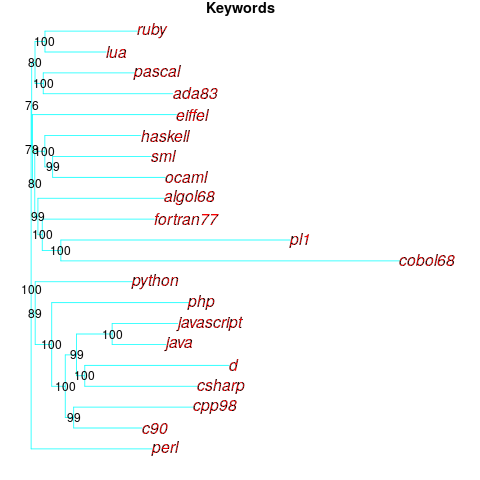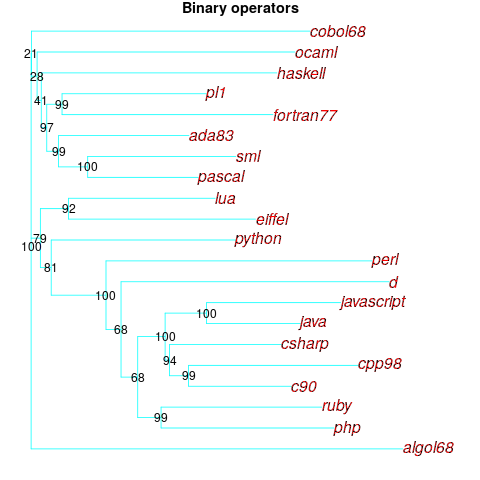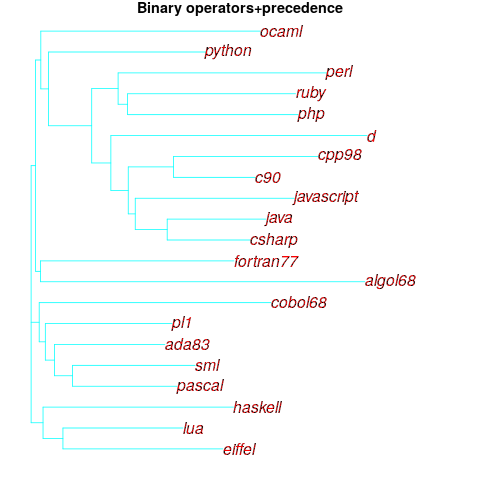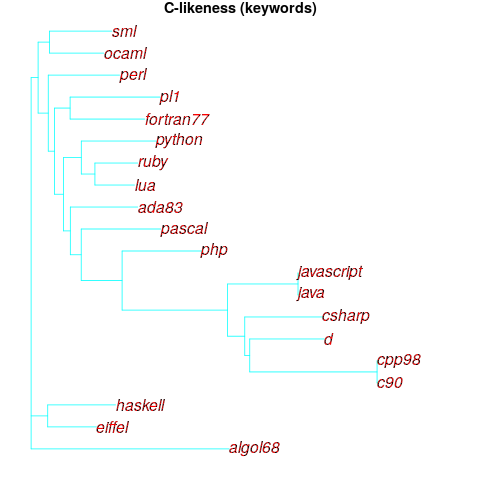Archive
Evidence-based Software Engineering: now in paperback form
I made my Evidence-based Software Engineering book available as a pdf file. While making a printed version available looked possible, I was uncertain that the result would be of acceptable quality; the extensive use of color and an A4 page size restricted the number of available printers who could handle it. Email exchanges with several publishers suggested that the number of likely print edition copies sold would be small (based on experience with other books, under 100). The pdf was made available under a creative commons license.
Around half-million copies of the pdf have been downloaded (some partially).
A few weeks ago, I spotted a print version of this book on Amazon (USA). I have no idea who made this available. Is the quality any good? I was told that it was, so I bought a copy.
The printed version looks great, with vibrant colors, and is reasonably priced. It sits well in the hand, while reading. The links obviously don’t work for the paper version, but I’m well practised at using multiple fingers to record different book locations.
I have one report that the Kindle version doesn’t load on a Kindle or the web app.
If you love printed books, I heartily recommend the paperback version of Evidence-based Software Engineering; it even has a 5-star review on Amazon 😉
Programming language similarity based on their traits
A programming language is sometimes described as being similar to another, more wide known, language.
How might language similarity be measured?
Biologists ask a very similar question, and research goes back several hundred years; phenetics (also known as taximetrics) attempts to classify organisms based on overall similarity of observable traits.
One answer to this question is based on distance matrices.
The process starts by flagging the presence/absence of each observed trait. Taking language keywords (or reserved words) as an example, we have (for a subset of C, Fortran, and OCaml):
if then function for do dimension object C 1 1 0 1 1 0 0 Fortran 1 0 1 0 1 1 0 OCaml 1 1 1 1 1 0 1 |
The distance between these languages is calculated by treating this keyword presence/absence information as an n-dimensional space, with each language occupying a point in this space. The following shows the Euclidean distance between pairs of languages (using the full dataset; code+data):
C Fortran OCaml C 0 7.615773 8.717798 Fortran 7.615773 0 8.831761 OCaml 8.717798 8.831761 0 |
Algorithms are available to map these distance pairs into tree form; for biological organisms this is known as a phylogenetic tree. The plot below shows such a tree derived from the keywords supported by 21 languages (numbers explained below, code+data):

How confident should we be that this distance-based technique produced a robust result? For instance, would a small change to the set of keywords used by a particular language cause it to appear in a different branch of the tree?
The impact of small changes on the generated tree can be estimated using a bootstrap technique. The particular small-change algorithm used to estimate confidence levels for phylogenetic trees is not applicable for language keywords; genetic sequences contain multiple instances of four DNA bases, and can be sampled with replacement, while language keywords are a set of distinct items (i.e., cannot be sampled with replacement).
The bootstrap technique I used was: for each of the 21 languages in the data, was: add keywords to one language (the number added was 5% of the number of its existing keywords, randomly chosen from the set of all language keywords), calculate the distance matrix and build the corresponding tree, repeat 100 times. The 2,100 generated trees were then compared against the original tree, counting how many times each branch remained the same.
The numbers in the above plot show the percentage of generated trees where the same branching decision was made using the perturbed keyword data. The branching decisions all look very solid.
Can this keyword approach to language comparison be applied to all languages?
I think that most languages have some form of keywords. A few languages don’t use keywords (or reserved words), and there are some edge cases. Lisp doesn’t have any reserved words (they are functions), nor technically does Pl/1 in that the names of ‘word tokens’ can be defined as variables, and CHILL implementors have to choose between using Cobol or PL/1 syntax (giving CHILL two possible distinct sets of keywords).
To what extent are a language’s keywords representative of the language, compared to other languages?
One way to try and answer this question is to apply the distance/tree approach using other language traits; do the resulting trees have the same form as the keyword tree? The plot below shows the tree derived from the characters used to represent binary operators (code+data):

A few of the branching decisions look as-if they are likely to change, if there are changes to the keywords used by some languages, e.g., OCaml and Haskell.
Binary operators don’t just have a character representation, they can also have a precedence and associativity (neither are needed in languages whose expressions are written using prefix or postfix notation).
The plot below shows the tree derived from combining binary operator and the corresponding precedence information (the distance pairs for the two characteristics, for each language, were added together, with precedence given a weight of 20%; see code for details).

No bootstrap percentages appear because I could not come up with a simple technique for handling a combination of traits.
Are binary operators more representative of a language than its keywords? Would a combined keyword/binary operator tree would be more representative, or would more traits need to be included?
Does reducing language comparison to a single number produce something useful?
Languages contain a complex collection of interrelated components, and it might be more useful to compare their similarity by discrete components, e.g., expressions, literals, types (and implicit conversions).
What is the purpose of comparing languages?
If it is for promotional purposes, then a measurement based approach is probably out of place.
If the comparison has a source code orientation, weighting items by source code occurrence might produce a more applicable tree.
Sometimes one language is used as a reference, against which others are compared, e.g., C-like. How ‘C-like’ are other languages? Taking keywords as our reference-point, comparing languages based on just the keywords they have in common with C, the plot below is the resulting tree:

I had expected less branching, i.e., more languages having the same distance from C.
New languages can be supported by adding a language file containing the appropriate trait information. There is a Github repo, prog-lang-traits, send me a pull request to add your language file.
It’s also possible to add support for more language traits.
Ecology as a model for the software world
Changing two words in the Wikipedia description of Ecology gives “… the study of the relationships between software systems, including humans, and their physical environment”; where physical environment might be taken to include the hardware on which software runs and the hardware whose behavior it controls.
What do ecologists study? Wikipedia lists the following main areas; everything after the first sentence, in each bullet point, is my wording:
- Life processes, antifragility, interactions, and adaptations.
Software system life processes include its initial creation, devops, end-user training, and the sales and marketing process.
While antifragility is much talked about, it is something of a niche research topic. Those involved in the implementations of safety-critical systems seem to be the only people willing to invest the money needed to attempt to build antifragile software. Is N-version programming the poster child for antifragile system software?
Interaction with a widely used software system will have an influence on the path taken by cultures within associated microdomains. Users adapt their behavior to the affordance offered by a software system.
A successful software system (and even unsuccessful ones) will exist in multiple forms, i.e., there will be a product line. Software variability and product lines is an active research area.
- The movement of materials and energy through living communities.
Is money the primary unit of energy in software ecosystems? Developer time is needed to create software, which may be paid for or donated for free. Supporting a software system, or rather supporting the needs of the users of the software is often motivated by a salary, although a few do provide limited free support.
What is the energy that users of software provide? Money sits at the root; user attention sells product.
- The successional development of ecosystems (“… succession is the process of change in the species structure of an ecological community over time.”)
Before the Internet, monthly computing magazines used to run features on the changing landscape of the computer world. These days, we have blogs/podcasts telling us about the latest product release/update. The Ecosystems chapter of my software engineering book has sections on evolution and lifespan, but the material is sparse.
Over the longer term, this issue is the subject studied by historians of computing.
Moore’s law is probably the most famous computing example of succession.
- Cooperation, competition, and predation within and between species.
These issues are primarily discussed by those interested in the business side of software. Developers like to brag about how their language/editor/operating system/etc is better than the rest, but there is no substance to the discussion.
Governments have an interest in encouraging effective competition, and have enacted various antitrust laws.
- The abundance, biomass, and distribution of organisms in the context of the environment.
These are the issues where marketing departments invest in trying to shift the distribution in their company’s favour, and venture capitalists spend their time trying to spot an opportunity (and there is the clickbait of language popularity articles).
The abundance of tools/products, in an ecosystem, does not appear to deter people creating new variants (suggesting that perhaps ambition or dreams are the unit of energy for software ecosystems).
- Patterns of biodiversity and its effect on ecosystem processes.
Various kinds of diversity are important for biological systems, e.g., the mutual dependencies between different species in a food chain, and genetic diversity as a resource that provides a mechanism for species to adapt to changes in their environment.
It’s currently fashionable to be in favour of diversity. Diversity is so popular in ecology that a 2003 review listed 24 metrics for calculating it. I’m sure there are more now.
Diversity is not necessarily desired in software systems, e.g., the runtime behavior of source code should not depend on the compiler used (there are invariably edge cases where it does), and users want different editor command to be consistently similar.
Open source has helped to reduce diversity for some applications (by reducing the sales volume of a myriad of commercial offerings). However, the availability of source code significantly reduces the cost/time needed to create close variants. The 5,000+ different cryptocurrencies suggest that the associated software is diverse, but the rapid evolution of this ecosystem has driven developers to base their code on the source used to implement earlier currencies.
Governments encourage competitive commercial ecosystems because competition discourages companies charging high prices for their products, just because they can. Being competitive requires having products that differ from other vendors in a desirable way, which generates diversity.
NoEstimates panders to mismanagement and developer insecurity
Why do so few software development teams regularly attempt to estimate the duration of the feature/task/functionality they are going to implement?
Developers hate giving estimates; estimating is very hard and estimates are often inaccurate (at a minimum making the estimator feel uncomfortable and worse when management treats an estimate as a quotation). The future is uncertain and estimating provides guidance.
Managers tell me that the fear of losing good developers dissuades them from requiring teams to make estimates. Developers have told them that they would leave a company that required them to regularly make estimates.
For most of the last 70 years, demand for software developers has outstripped supply. Consequently, management has to pay a lot more attention to the views of software developers than the views of those employed in most other roles (at least if they want to keep the good developers, i.e., those who will have no problem finding another job).
It is not difficult for developers to get a general idea of how their salary, working conditions and practices compares with other developers in their field/geographic region. They know that estimating is not a common practice, and unless the economy is in recession, finding a new job that does not require estimation could be straight forward.
Management’s demands for estimates has led to the creation of various methods for calculating proxy estimate values, none of which using time as the unit of measure, e.g., Function points and Story points. These methods break the requirements down into smaller units, and subcomponents from these units are used to calculate a value, e.g., the Function point calculation includes items such as number of user inputs and outputs, and number of files.
How accurate are these proxy values, compared to time estimates?
As always, software engineering data is sparse. One analysis of 149 projects found that  , with the variance being similar to that found when time was estimated. An analysis of Function point calculation data found a high degree of consistency in the calculations made by different people (various Function point organizations have certification schemes that require some degree of proficiency to pass).
, with the variance being similar to that found when time was estimated. An analysis of Function point calculation data found a high degree of consistency in the calculations made by different people (various Function point organizations have certification schemes that require some degree of proficiency to pass).
Managers don’t seem to be interested in comparing estimated Story points against estimated time, preferring instead to track the rate at which Story points are implemented, e.g., velocity, or burndown. There are tiny amounts of data comparing Story points with time and Function points.
The available evidence suggests a relationship connecting Function points to actual time, and that Function points have similar error bounds to time estimates; the lack of data means that Story points are currently just a source of technobabble and number porn for management power-points (send me Story point data to help change this situation).
4,000 vs 400 vs 40 hours of software development practice
What is the skill difference between professional developers and newly minted computer science graduates?
Practice, e.g., 4,000 vs. 400 hours
People get better with practice, and after two years (around 4,000 hours) a professional developer will have had at least an order of magnitude more practice than most students; not just more practice, but advice and feedback from experienced developers. Most of these 4,000 hours are probably not the deliberate practice of 10,000 hours fame.
It’s understandable that graduates with a computing degree consider themselves to be proficient software developers; this opinion is based on personal experience (i.e., working with other students like themselves), and not having spent time working with professional developers. It’s not a joke that a surprising number of academics don’t appreciate the student/professional difference, the problem is that some academics only ever get to see a limit range of software development expertise (it’s a question of incentives).
Surveys of student study time have found that for Computer science, around 50% of students spend 11 hours or more, per week, in taught study and another 11 hours or more doing independent learning; let’s take 11 hours per week as the mean, and 30 academic weeks in a year. How much of the 330 hours per year of independent learning time is spent creating software (that’s 1,000 hours over a three-year degree, assuming that any programming is required)? I have no idea, and picked 40% because it matched up with 4,000.
Based on my experience with recent graduates, 400 hours sounds high (I have no idea whether an average student spends 4-hours per week doing programming assignments). While a rare few are excellent, most are hopeless. Perhaps the few hours per week nature of their coding means that they are constantly relearning, or perhaps they are just cutting and pasting code from the Internet.
Most graduates start their careers working in industry (around 50% of comp sci/maths graduates work in an ICT profession; UK higher-education data), which means that those working in industry are ideally placed to compare the skills of recent graduates and professional developers. Professional developers have first-hand experience of their novice-level ability. This is not a criticism of computing degrees; there are only so many hours in a day and lots of non-programming material to teach.
Many software developers working in industry don’t have a computing related degree (I don’t). Lots of non-computing STEM degrees give students the option of learning to program (I had to learn FORTRAN, no option). I don’t have any data on the percentage of software developers with a computing related degree, and neither do I have any data on the average number of hours non-computing STEM students spend on programming; I’ve cosen 40 hours to flow with the sequence of 4’s (some non-computing STEM students spend a lot more than 400 hours programming; I certainly did). The fact that industry hires a non-trivial number of non-computing STEM graduates as software developers suggests that, for practical purposes, there is not a lot of difference between 400 and 40 hours of practice; some companies will take somebody who shows potential, but no existing coding knowledge, and teach them to program.
Many of those who apply for a job that involves software development never get past the initial screening; something like 80% of people applying for a job that specifies the ability to code, cannot code. This figure is based on various conversations I have had with people about their company’s developer recruitment experiences; it is not backed up with recorded data.
Some of the factors leading to this surprisingly high value include: people attracted by the salary deciding to apply regardless, graduates with a computing degree that did not require any programming (there is customer demand for computing degrees, and many people find programming is just too hard for them to handle, so universities offer computing degrees where programming is optional), concentration of the pool of applicants, because those that can code exit the applicant pool, leaving behind those that cannot program (who keep on applying).
Apologies to regular readers for yet another post on professional developers vs. students, but I keep getting asked about this issue.
Recent Comments